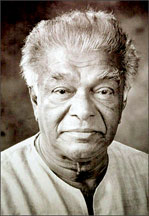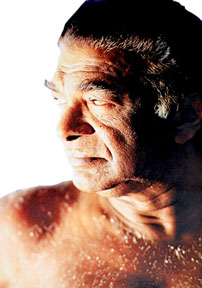Arts
High priest of dancing who epitomised the essence of the craft
87th birth Anniversary of Chithrasena:
by Ranga Chandrarathne
|

Chithrasena
|
A year has passed since the death of Chithrasena, a cultural icon who
uplifted the rudimentary form of Sri Lankan folk drama to suit modern
stage.
His death marked not only an end of an era which was dominated by
cultural giants who had shaped the soul of independent Sri Lanka but
also the emergence of a culturally alienated generation who have become
victims of popular culture dominated by cheap movie stars from Hollywood
and Bollywood.
His death occurred against the back drop of deteriorating indigenous
arts and the sweeping wind of alienism in the spheres of culture,
language and system of social values that have been held sacred for
centuries. Sri Lankan dancing has been degraded to the status of being
an ornamental art which is common at weddings, openings to beautify
these occasions.
Little or no attention was paid to the fact that dancing as any form
of art, can stand on its own and is capable of conveying a myriad of
emotions addressing the inner-most feelings of mankind by means of body
movement within a well-crafted choreography.
Though sweeping commercialism is to be blamed for the situation,
other factors such as the dwindling audience for serious art and the
absence of the culture of appreciating serious work of art have also
contributed to the present crisis in dancing. Against this back drop, it
is not an estrange phenomenon that dancing has rendered as a highly
commercilised 'flash art' which is of momentary value.
 Another factor that adversely affects contemporary dancing in Sri
Lanka is the absence of informed criticism on dancing. This is, perhaps,
due to the sheer lack of attention and recognition paid to dancing as a
serious art form and also due to the gross ignorance on the part of a
mushrooming fraternity of critics. Another factor that adversely affects contemporary dancing in Sri
Lanka is the absence of informed criticism on dancing. This is, perhaps,
due to the sheer lack of attention and recognition paid to dancing as a
serious art form and also due to the gross ignorance on the part of a
mushrooming fraternity of critics.
It should be mentioned here that though there had been a somewhat
evolved culture of criticism with regard to literature, paintings and
visual and performing arts, it was rare to see an informed criticism on
dancing or a ballet.
Even the established critics were reluctant to make a commentary of a
ballet owing, perhaps, to ignorance of language and idiom to describe
ballet or the unrepentant acceptance of the widespread myth that dancing
is an art for cheap entertainment. It is pity, however, that this
callous disregard on the part of a fraternity of critics has, by and
large, contributed to re-affirm the popular myth on dancing.
It is pertinent, at this point, to revisit the Chitrasena's practice
of dancing and his masterpieces, especially in the light of the present
crisis in Sri Lankan dancing which has been relegated to as a cheap form
of entertainment, appealing to raw senses.
One of the significant features of Chithrasena's practices was that
his consideration of dancing not as a mere form of art which manifests
Sri Lankan culture but an art capable of expressing one's inner-most
soul. He emphasized this fact in performances such as Nurthanjali and
Navanjali which were adapted to traditional theatre.
Through his larger-than-life personality, Chithrasena has left
indelible footprints in the arena of Sri Lankan dancing. Perhaps, he
will be remembered by the posterity as a peerless pioneer who uplifted
the Sri Lankan tradition of dancing from its status of being a ritual to
a fully-fledged art form suitable for proscenium stage.
 He not only introduced ballet to Sri Lankan theatre but was also the
pioneering choreographer in Sri Lankan dancing. He not only introduced ballet to Sri Lankan theatre but was also the
pioneering choreographer in Sri Lankan dancing.
He laid the firm foundation for dancing admixing new features to it,
making it suitable even for an international audience. His stage
personality has become a prototype for aspiring dancers and he created
theatrical marvels in his monumental work, ballet Karadiya.
For instance, the dream scene in Karadiya is a fine example of
creating theatrical marvels which are inherently linked to the work.
Most of the scenes in ballets Nala Damayanthi and Shivaranga remind us
of the mystic quality in Asian myths. On the other hand, Kinkini Kolama
manifests visual features of old Sri Lankan folk theatre.
Dancing in a broader perspective is an art which portrays the
material world, beauty and rhythmic movements of the body. It not only
provides a fresh perspective of life for the dancer but also for the
deserving audience.
The essence of dancing, irrespective of diverse traditions, lies in
its ability to entertain the dancer through rhythmic movements of the
body and to convey it to the audience as an expression of emotions.
It is in this light that we should appreciate Chithrasena and his
trailblazing career in dancing. Chithrasena's practice would strike a
delicate balance between two extremes of totally being materialistic and
being spiritual, completely forgetting the existence of the body.
[email protected] |
